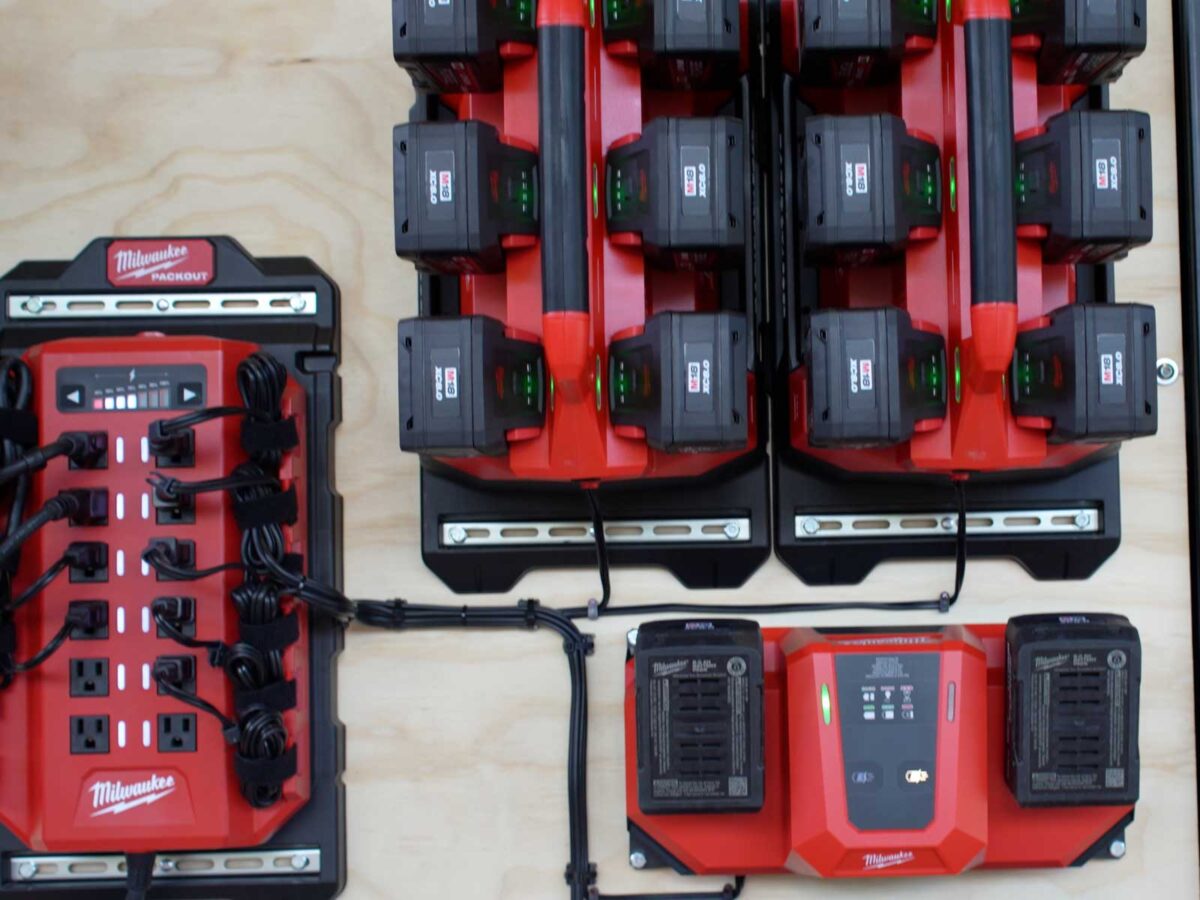I first saw the Milwaukee Power Manager (model 3333-15A and 3333-20A) at the company’s 2024 Pipeline event. It was paired with a wall of M18 Six Bay Daisy Chain Rapid Chargers (48-59-1817). The power manager offers an intelligent and efficient battery management solution for charging up to dozens of Milwaukee batteries. In particular, the Power Manager prevents circuit overloads while allowing for way more than 20 amps worth of chargers to be connected to a single 15A or 20A circuit. There seem to be (at least) three solid ways to use the Milwaukee Power Manager. I’ll cover each one so you can see if it’s a good fit for your needs.
What the Power Manager Does in a Nutshell
As you can imagine, using a simple power strip or even attaching chargers all over your current-limited shop or garage would quickly trip a breaker. With lots of batteries to charge, you either need to increase your service or add more branch circuits. You may also have to babysit the process to ensure nothing trips the breakers.
A better solution would be a device that can start and stop charging while ensuring the overall power draw never exceeds 15 or 20 amps. A simple power strip can’t do that. I would know because our shop uses “dumb” power strips for our rather impressive battery wall. The Milwaukee Power Manager does what its name implies. It “governs” or manages the power from your available circuits so that your chargers can work sequentially. This lets multiple chargers fill and top off your batteries until everything is at 100%.
For this article, I used the Milwaukee Power Manager alongside an M18 Six Bay Daisy Chain Rapid Charger. I also plugged other chargers and devices into the power manager to get a feel for how it prioritized power.

Power Manager (3333-15A / 3333-20A) Features
The Milwaukee Power Manager is engineered to let users use either 15-amp or 20-amp branch circuits to connect multiple M12, M18, and even MX FUEL chargers without overloading the electrical system. The system integrates several key technologies and features that let it do this.
First, Intelligent Power Switching automatically monitors and distributes power across each of the 12 outlets. The system monitors the load and activates additional outlets as power becomes available. This prevents the overloading of circuits while providing the maximum amount of power possible through the available outlets.
Power Prioritization
The system prioritizes the upper (lower numbered) outlets and goes left to right. This means you can prioritize connections and optimize charging as needed and desired. You get twelve total outlets, each equipped with its own indicator light to display the status:
- Solid white – full power is available
- Blinking white – outlet is waiting to be tested
Note: If the power is insufficient for a particular outlet, it will be tested 3 times before going inactive for 1 hour. During testing, all downstream outlets will be deactivated. After 1 hour, any deactivated outlets are tested again. If sufficient power is available, it will activate. If not, it will continue the cycle.

Power Throttling
Above simply turning on and off outlets, the system also includes a Power Throttle feature. This allows users to customize the total power draw to accommodate other devices on the same circuit. You can adjust it between 3 (5.1 amps max) and 7 (12 amps max). For example, you can provide 5 amps of “headroom” for another device and limit your 15-amp Power Manager to just ~7 amps. An indicator at the top shows you the active power usage. As connected devices begin to pull power, the power level indicators change from white to red. This shows you the total draw up to the set maximum.

Milwaukee Packout Compatibility
The Milwaukee Power Manager stacks easily on a portable Milwaukee Packout rig or on a Packout wall. You can easily bring it to the jobsite or even mount it to a wall in an enclosed trailer, garage workshop, or commercial shop space like ours.
M18 Six Bay Daisy Chain Rapid Charger (48-59-1817) Features
The Milwaukee M18 Six Bay Daisy Chain Rapid Charger has a long name, but it helps clarify its purpose. Don’t buy this model if you simply need a rapid charger or a way to charge six batteries. This particular charger is designed to work alongside others for sequential charging in an enclosed trailer, on the wall, or in a tool crib or shop space. With it, you can efficiently manage the charging of multiple M18 batteries.
Dual Charging Modes
One of the unique features of the Milwaukee M18 Six Bay Daisy Chain Rapid Charger is its dual charging modes. This gives you some flexibility in just how you use this product. It really opens it up to multiple applications. you don’t get with a standard rapid charger or even Milwaukee’s other 6-port chargers.
Rapid Daytime Charging Mode
Using just a single unit, it has both an A and B side that each charge one battery at a time. That gives you two batteries that charge simultaneously when you need faster results. It also charges at a rate that doubles that of Milwaukee standard chargers.
Overnight Charging Mode
You can also daisy-chain up to 10 of these chargers. This lets you charge up to sixty (60) M18 batteries on a single 15-amp circuit without tripping any breakers. For overnight charging applications, this presents a hands-off method of power management I hadn’t seen before. And I certainly haven’t seen it for ~$500.

Other Features
Like the Power Manager, the M18 Six Bay Daisy Chain Rapid Charger works with Milwaukee PACKOUT boxes, wall mounts, and shelves. It also features built-in cord management and a folding handle for easy transport and storage.
Three Ways You Can Use the Milwaukee Power Manager
With the above in mind, I wanted to cover three great ways you could use the Milwaukee Power Manager in your garage, shop, or business. These applications show how you can streamline battery charging and take the worry out of getting your tools ready for work the next day.
Scenario #1 – Home Garage or Workshop
For serious DIYers or anyone with a workshop, managing multiple battery-powered tools can be challenging. Implementing the Power Manager with the Six Bay Charger offers several advantages. First, you can safely operate any combination of chargers—even across different brands—on a single 15A circuit. Second, you can use the power throttling feature of the Milwaukee Power Manager to reserve enough power to operate other devices while you charge batteries.

Finally, having a system like this allows you to conveniently access the unit using Packout wall mounts. I find this arrangement is truly convenient for centrally locating your chargers and devices. It reduces clutter and helps you organize your garage or shop space.
Primary Advantage: Organization. The system’s design combines centralized charger organization with powerful and flexible battery management.
Scenario #2 – Tool Crib
In professional settings where numerous batteries require charging, the power manager delivers several important features. First and foremost, you get scalability. Using the Milwaukee Power Manager lets you charge up to sixty (60) M18 batteries on a single branch circuit! Need more? Just add more power managers and chargers—each to a different branch circuit.
The second advantage has to be the ability to easily mix and match chargers for bulk charging tools. Not only can the power manager handle any combination of M12, M18, and MX Fuel chargers, but it can also work with your other brands’ battery chargers.

The third advantage is reliability. You can’t afford to close up the tool crib and not have those batteries fully charged in the morning. For mission-critical applications, knowing that your breakers aren’t going to trip on you delivers peace of mind. The built-in circuit protection of the Milwaukee Power Manager takes care of this automagically…letting you worry about other aspects of your job.
Primary Advantage: Expandability. Adding additional chargers and power managers is easy. Coming up with the best combination for your tool crib is easy. It also, however, lets you expand your business when you need to add more chargers.
Scenario #3 – Enclosed Trailers for Tradesmen and Landscapers
For mobile operations such as landscaping and on-site trades, having a wall-mounted battery management solution can be a lifesaver. In an enclosed trailer, the combination of a power manager and several M18 Six Bay Daisy Chain Rapid Chargers means you can come back to the home or shop, plug in a single cord, and recharge all of your batteries overnight. It’s the ultimate mobile charging solution.
The system also has the benefit of easily organizing otherwise unused space in your trailer, optimizing it for wall-mounted chargers. Whether you use Milwaukee Packout wall mounts or some other solution, it reclaims valuable floor space for your tools.

Overnight charging also saves you money as it leverages lower energy costs during off-peak hours. Combined with the convenience of one-cord connectivity, this sort of mobile-optimized solution should work well for any business.
Primary Advantage: Convenience. With a trailer, you want to plug in a single cable and charge all of your tools’ batteries. The Milwaukee Power Manager makes this not only possible, but also reliable for ensuring everything is ready for work the next day.
Final Thoughts
I highlighted three potential scenarios, but I’m certain there are more. What’s important is that manufacturers like Milwaukee are finally starting to grasp that crews switching to battery-only tools require all-day runtime. They also require easy and workable solutions for recharging their batteries at the end of the day. The lack of viable and convenient charging solutions can cripple a crew or company and introduce all manner of problems into your workflow.
Products like the Milwaukee Power Manager are encouraging as they represent affordable, real-world solutions to an emerging problem. We’re starting to see more and more manufacturers address these issues—though in different ways. I hope the trend continues as it can only serve to help tradesmen and other professionals.



